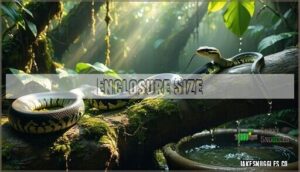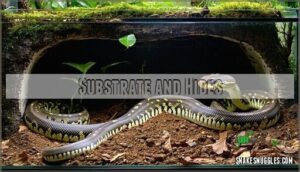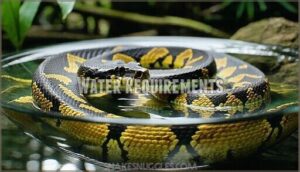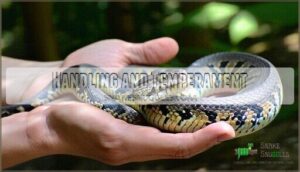This site is supported by our readers. We may earn a commission, at no cost to you, if you purchase through links.
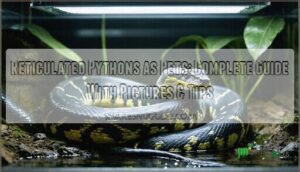 You’re considering one of the world’s largest snakes as a companion – reticulated pythons can stretch over 20 feet and weigh 200+ pounds.
You’re considering one of the world’s largest snakes as a companion – reticulated pythons can stretch over 20 feet and weigh 200+ pounds.
These Indonesian giants aren’t beginner pets; they’ll need custom-built enclosures, precise temperature control, and your complete respect.
You’ll handle feeding rabbits or chickens every few weeks, maintaining 80-88°F temperatures, and always using two-person handling protocols for safety.
Their striking diamond patterns make them stunning, but their size means serious liability concerns.
Most reticulated pythons as pets require permits, specialized veterinary care, and lifelong commitment spanning 20-30 years.
The housing setup alone costs thousands, but proper preparation makes all the difference.
Table Of Contents
- Key Takeaways
- Reticulated Python Overview
- Enclosure Requirements
- Feeding and Diet
- Handling and Temperament
- Health and Veterinary Care
- Frequently Asked Questions (FAQs)
- Are reticulated pythons good pets?
- Are reticulated pythons sociable?
- How do you pet a reticulated python?
- Are reticulated pythons beautiful?
- Should I buy a reticulated python?
- What is a reticulated python?
- Do reticulated pythons make good pets?
- Can you own a reticulated python as a pet?
- What is the best enclosure for a reticulated python?
- Has a reticulated python ever killed a human?
- Conclusion
Key Takeaways
- You’ll need a massive custom enclosure matching your snake’s full length (potentially 8x4x4 feet for adults), precise temperature control between 75-92°F, and thousands of dollars for proper housing setup alone.
- You’re committing to 20-30 years of specialized care including feeding rabbits or chickens every few weeks, maintaining strict humidity levels, and always using two-person handling protocols for safety with these 200+ pound giants.
- You’ll require permits in most areas, access to qualified reptile veterinarians experienced with large snakes, and extensive knowledge since these aren’t beginner pets—only dwarf varieties are suitable for most keepers.
- You’re taking on serious liability concerns and potential danger, as reticulated pythons have documented cases of killing humans through constriction, making respect and proper safety protocols absolutely essential.
Reticulated Python Overview
Before diving into the realm of giant snakes, you’ll want to understand what makes reticulated pythons so remarkable.
These Python reticulatus specimens from Southeast Asia represent the world’s longest snake species, with their reticulated python size reaching over 30 feet in wild populations.
These magnificent serpents from Southeast Asia claim the title of world’s longest snake, with wild specimens stretching beyond 30 incredible feet.
Their Physical Traits include stunning diamond-patterned scales that create perfect camouflage in their Natural Habitat across Indonesia, Malaysia, and surrounding regions.
These snakes also possess heat-sensing pit organs that aid in detecting warm-blooded prey.
Don’t let their impressive Python Size fool you—their Snake Temperament can be surprisingly docile with proper handling.
In captivity, you’re looking at a Captive Lifespan of 15-25 years with dedicated care.
Enclosure Requirements
You’ll need a massive enclosure that matches your reticulated python’s impressive size, as these giants require room to stretch their full length and move comfortably.
Proper housing isn’t just about space—you’ll also need to carefully manage temperature gradients, humidity levels, secure substrates, and sturdy hiding spots to keep your python healthy and stress-free.
Enclosure Size
Getting your reticulated python’s housing right means understanding space calculation basics.
Your snake’s enclosure size should match its adult length, with width at least half that measurement. These suitably large enclosure requirements vary by locality – dwarf varieties need less room than standard retics.
Many keepers source their python enclosure products online.
Minimum Dimensions for Reticulated Python Enclosure:
- Length equals snake’s full-grown size
- Width measures half the snake’s length
- Height allows climbing and stretching movements
- Custom builds often required for larger specimens
- Enrichment needs increase with enclosure size
Substrate and Hides
Your reticulated python needs substrate types like cypress mulch or coconut fiber, layered 4-6 inches deep for humidity retention and naturalistic burrowing.
Place sturdy hides on both temperature zones—sized so your snake coils comfortably without excess space. Hide size matters: too large feels insecure, too small causes stress.
Spot-clean waste immediately, with full substrate replacement monthly. Consider specialized python substrates for ideal health.
This cleaning frequency prevents bacterial growth while maintaining proper enclosure requirements.
Heating and Lighting
Your retic needs proper temperature gradients with basking spots reaching 88-92°F and cool areas at 75-78°F.
Heat sources like ceramic heaters work well, while UVB lighting supports calcium absorption.
Maintain consistent light cycles of 12 hours on/off.
Thermostats prevent dangerous overheating—you can’t eyeball these temperatures.
For ideal basking, consider using a quality heat bulb.
Quality heating and lighting equipment isn’t optional for healthy pythons.
Humidity and Water
Humidity levels between 50-70% keep your python healthy—use a hygrometer to track this precisely.
A large water source provides drinking and soaking opportunities, while strategic misting techniques boost moisture when needed.
Monitor for dehydration symptoms like sunken eyes or stuck shed.
Proper hydration and humidity prevent respiratory infections and guarantee smooth shedding cycles.
Maintaining proper humidity is vital, as low levels cause shedding.
Feeding and Diet
You’ll need to establish a proper feeding routine that matches your reticulated python’s size and age, as these powerful constrictors require substantial meals ranging from mice for juveniles to rabbits for adults.
Getting the prey size, feeding frequency, and water setup right becomes essential for maintaining your snake’s health.
Since improper nutrition can lead to obesity, stunted growth, or digestive complications.
Prey Size and Type
Choosing the right prey size means matching the girth to your python’s thickest section.
Suitably sized rodents like rats work best for juveniles, while adults graduate to rabbits.
Prey variety matters—rotate between different mammals and birds to meet nutritional needs.
Frozen vs live options both work, though frozen-thawed reduces injury risk during feeding sessions.
Ensuring a proper diet also means understanding essential vitamin D3 intake for calcium absorption.
Feeding Schedule
Getting your python’s feeding schedule right prevents obesity and supports healthy growth.
Meal frequency depends on age and size, while maintaining consistent timing helps establish proper python feeding habits.
- Hatchlings: Feed every 5-7 days with appropriate prey size
- Juveniles under 10 feet: Every 10-14 days
- Large adults: Every 2-3 weeks
- Breeding females: Every 10 days during season
Water Requirements
Your reticulated python needs a large water bowl that’s sturdy enough for soaking without tipping over.
Your giant python deserves a water bowl that won’t become a swimming pool disaster when they decide to take a soak.
Fresh, clean water supports proper hydration and aids shedding by maintaining humidity levels.
Choose bowls wide enough for your snake’s body, as these giants love soaking opportunities.
Change water weekly or when contaminated, and monitor for dehydration signs like sunken eyes.
Handling and Temperament
You’ll need to approach your reticulated python with confidence and proper technique, as these intelligent snakes can sense hesitation and may respond with defensive behavior if they feel threatened.
While retics generally display calm temperaments compared to their reputation, they’re still powerful constrictors that require respect, consistent handling practices, and an understanding of their body language to build trust over time.
Safe Handling Techniques
Handling a reticulated python isn’t like picking up your average pet.
You’ll need proper grip techniques, supporting their muscular body while never restraining the head. Recognizing stress signals prevents dangerous situations, and specialized handling tools like snake hooks provide extra safety margin.
Essential python handling tips include:
- Proper Grip: Support the body weight with both hands, maintaining gentle but secure contact
- Lifting Techniques: Use smooth, deliberate movements to avoid startling your snake
- Avoiding Bites: Watch for defensive posturing and retreat when your python shows aggression
Aggression and Bites
Bite severity from reticulated pythons shouldn’t be underestimated—their powerful jaws can inflict wounds requiring stitches.
Handling risks increase when you present warm objects within striking range, triggering their ferocious feeding response.
Defensive behaviors like striking occur when they feel threatened.
Mitigation strategies include using proper tools, maintaining calm movements, and recognizing aggression warning signs to prevent snake bites effectively.
Socialization and Taming
Beyond managing aggressive episodes, building trust transforms your reticulated python into a calm companion.
Regular handling frequency creates familiarity, while interaction benefits include reduced stress and improved temperament.
Your python temperament guide starts with patience—owning reticulated python means understanding their intelligence.
Effective taming methods for building trust include:
- Consistent gentle handling using slow, deliberate movements
- Environmental enrichment with climbing structures and novel textures
- Positive reinforcement through supervised exploration sessions
Health and Veterinary Care
Your reticulated python’s health depends on preventive care, regular monitoring, and access to an experienced reptile veterinarian who understands these complex animals.
You’ll need to watch for common issues like respiratory infections, mites, and feeding problems while establishing a relationship with a qualified exotic animal vet before emergencies arise.
Common Health Issues
Respiratory infections top the list of python health issues you’ll encounter. Watch for wheezing, mouth breathing, or nasal discharge—these signal pneumonia requiring immediate veterinary attention.
Scale rot develops from excessive moisture, while mite infestations cause restlessness and skin irritation.
Digestive problems manifest as regurgitation or refusal to eat. Parasites and obesity also threaten your snake’s wellbeing, demanding prompt professional care to address these health issues.
Preventive Care
Prevention beats cure regarding python health issues. You’ll want to establish solid quarantine protocols for new arrivals and maintain consistent hygiene practices throughout your snake’s life.
Regular checkups with a qualified reptile veterinarian catch problems early, while proper parasite control keeps your python thriving.
- Schedule annual veterinary care appointments for thorough health assessments
- Implement quarantine protocols lasting 60-90 days for new pythons
- Provide shedding assistance with humid hides during shed cycles
- Monitor for python common diseases like respiratory infections and mites
Finding a Reptile Veterinarian
Most reptile veterinarians aren’t equipped for 20-foot pythons, so finding qualified veterinary care requires homework.
Search for exotic animal specialists with large snake experience, emergency protocols, and proper equipment. Ask about vet qualifications, emergency care availability, and cost considerations upfront.
Local availability matters—you’ll need someone familiar with common health issues in reticulated pythons when medical attention becomes urgent.
You can often find a suitable vet by using online directories for specialists.
Frequently Asked Questions (FAQs)
Are reticulated pythons good pets?
Think you’re ready for a 20-foot roommate? Reticulated pythons aren’t typical pets—they’re intelligent, long-lived giants requiring massive enclosures, specialized care, and serious commitment. Only dwarf varieties suit most keepers.
Are reticulated pythons sociable?
Reticulated pythons aren’t social creatures by nature.
They’re solitary animals that don’t seek companionship or interaction like mammals do.
You’ll find they prefer being alone and won’t benefit from having snake roommates.
How do you pet a reticulated python?
Approach your python slowly and confidently, letting it see your hands first.
Gently stroke along its body with smooth, deliberate movements.
Support its weight when lifting, and avoid touching its head initially, using smooth movements to ensure a calm interaction.
Are reticulated pythons beautiful?
Beauty lies in the eye of the beholder, and you’ll find these serpents absolutely stunning.
Their intricate diamond patterns create mesmerizing camouflage artwork across golden scales, making them living masterpieces that captivate reptile enthusiasts worldwide.
Should I buy a reticulated python?
Only consider dwarf or super dwarf varieties if you’re experienced with large snakes.
You’ll need massive space, significant financial commitment, and 20+ years of dedication.
Most people aren’t prepared for this responsibility.
What is a reticulated python?
You’re looking at the world’s longest snake species, Python reticulatus, native to Southeast Asia.
These massive constrictors can reach over 20 feet, featuring distinctive diamond-patterned scales in yellow, black, and white coloration.
Do reticulated pythons make good pets?
Reticulated pythons can make rewarding pets, but they’re not for beginners.
You’ll need extensive experience, a massive enclosure, and serious commitment.
Only dwarf varieties are suitable for most keepers due to their manageable size.
Can you own a reticulated python as a pet?
Don’t bite off more than you can chew—yes, you can legally own a reticulated python in most states.
But only dwarf varieties make suitable pets due to their manageable size and calmer temperament.
What is the best enclosure for a reticulated python?
You’ll need a massive custom enclosure matching your snake’s full length—that’s potentially 8x4x4 feet for adults.
Include sturdy branches, hiding spots, proper heating zones, and secure locks because these escape artists won’t hesitate to explore.
Has a reticulated python ever killed a human?
When nightmares become reality, yes—documented cases exist where reticulated pythons have killed humans through constriction.
You’ll find these tragic incidents typically involve wild encounters, escaped captives, or inadequate safety protocols during handling, which often lead to severe consequences, emphasizing the importance of safety protocols.
Conclusion
Owning reticulated pythons as pets requires dedication like tending a living sculpture that grows for decades.
You’ll need substantial financial resources, proper permits, and unwavering commitment to their complex care requirements.
These magnificent serpents aren’t suitable for novice keepers, but experienced reptile enthusiasts who understand their needs can form rewarding relationships with these impressive animals.
Remember, reticulated pythons as pets demand respect, patience, and fastidious attention to detail throughout their 20-30 year lifespan.
- https://coldblooded.com/read-blog/55_care-guide-pythons-reticulated-pythons.html?mode=day
- https://reptifiles.com/reticulated-python-care-sheet/
- https://www.anapsid.org/handling.html
- https://animaldiversity.org/accounts/Python_reticulatus/
- https://www.guinnessworldrecords.com/world-records/longest-snake-ever-(captivity)

